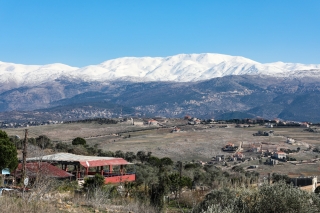Yale Schwarzman Center, along with the Yale Council of Middle East Studies, is proud to present an artist conversation about A Thousand Strange Places. This new play, directed and co-developed by Kirsten Sanderson, coincides with the 20th anniversary of the U.S. invasion of Iraq. It follows the career of renowned Lebanese-American journalist Anthony Shadid and is based on the Shadid archive housed at American University of Beirut’s Jafet Library.
YSC spoke with playwright, author and scholar Robert Myers, author of A Thousand Strange Places, about the life of the extraordinary Pulitzer Prize-winning journalist, the playwright’s artistic process and the ways in which he explores themes of interconnectivity and crossing boundaries in this new play.
What inspired you to create a play based on the life of Anthony Shadid?
I’ve taught for the last 18 years at the American University in Beirut. I’m a playwright and a literature professor, but I’m also the Director of the Alwaleed Center for American Studies and Research (CASAR), which was founded in 2004 with a mission of understanding the fraught relationship between east and west. I had the privilege to collaborate with the renowned journalist Rami Khouri, and he proposed that we use Anthony Shadid’s archive for pedagogical purposes. Shadid was an absolutely fascinating writer, reporter, and journalist. Since I have written 15 or 16 plays, a dozen of which are historical and documentary, when I looked at the material in the archive, I thought, “This is a play.” And so that is how A Thousand Strange Places came into being.
What was it about Anthony Shadid that impacted you or made hima compelling figure?
I couldn’t have found a more synergistic figure than Anthony Shadid—this kid who grew up in Oklahoma, learned Arabic as an adult and immersed himself in Arabic culture. It allowed him access to a world that was not available to other Western reporters, places like Anbar province. If you read the stories of people he talked to, you would get a counter narrative to the one being put out by the Pentagon. For example, he would have lunch with a Shia family—and these were the people who were ostensibly going to be rescued by the Americans. They were not happy about the American invasion and had vastly different point of view. So I loved researching and writing his story, because it allowed me to go back and re-experience my own time in the Middle East through Shadid’s experience.
As a storyteller, what parts of Shadid’s life did you pick to feature in the play and why?
I focus on the period from 2000 until his death in 2012. During that decade, he was a reporter, first in Afghanistan, and long before other Western reporters, he was insisting on going out to villages that had been bombed to see for himself. Even though Arabic isn’t the language that was spoken there, he understood that’s where the story was and was able to connect sufficiently with people to their story in a way that was authentic and engaging. Given the recent American withdrawal from Afghanistan, this story is timely and relevant today. I see this period that Shadid spent in Afghanistan as antecedent action for the American engagement with the Arab world, which is the focus of the play I wrote.
As a playwright, the story I’m telling is sort of the tip of the iceberg, but I’ve embedded within it a kind of complexity that performers and designers can draw upon—subtext and antecedent action.
